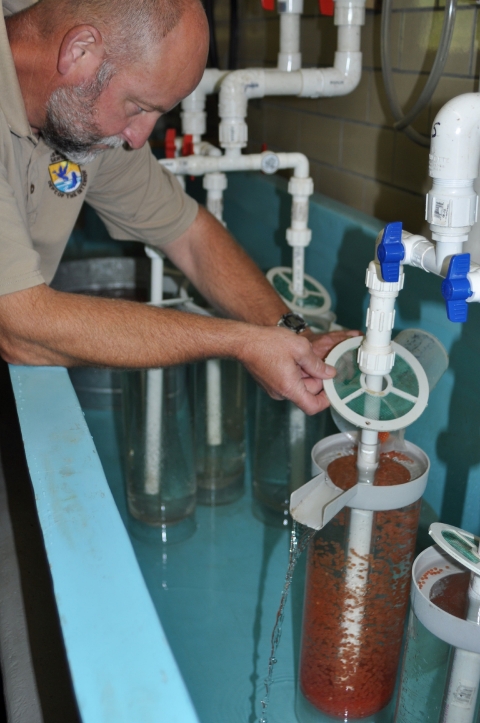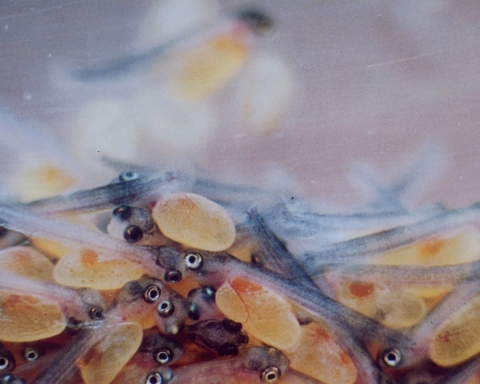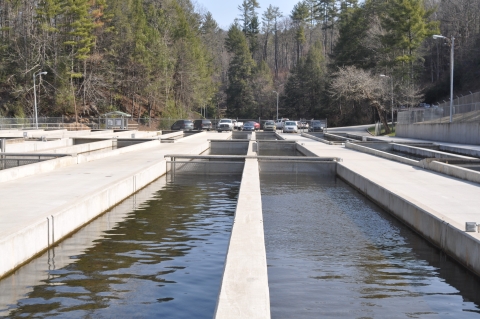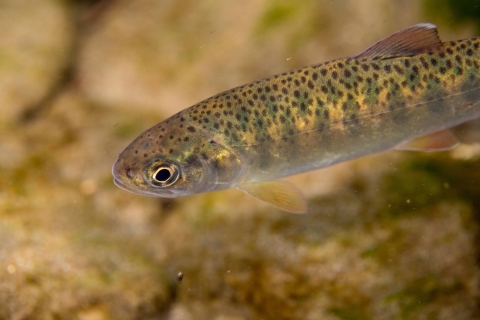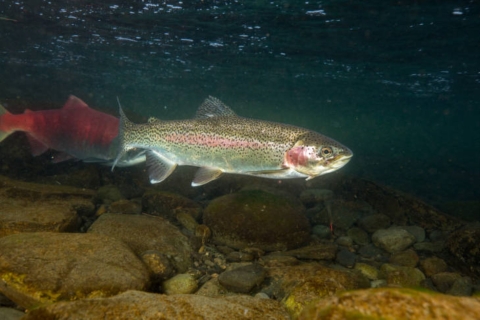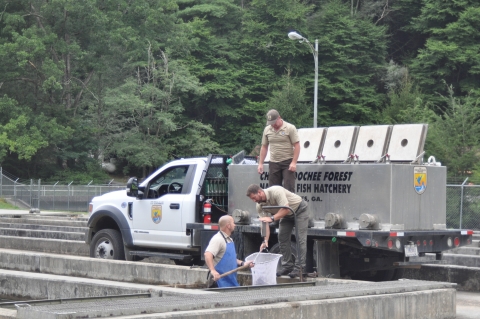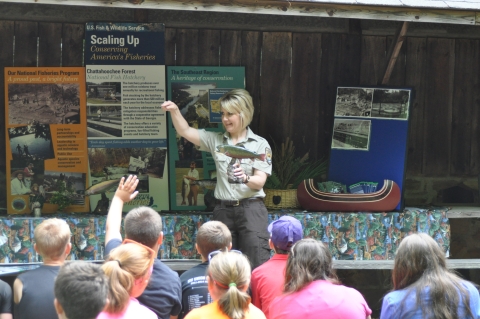Our Services
Trout Production and Stocking
Changes in water temperature and natural flow due to the environment, dams and reservoirs subsequently affect fish and aquatic resources. Fish are stocked in waters to serve important roles in the ecosystems and supplement fisheries.
Chattahoochee Forest National Fish Hatchery produces approximately one million trout per year that are stocked into public tailwaters, streams and lakes of northern Georgia in cooperation with the Georgia Department of Natural Resources, U.S. Forest Service, U.S. Army Corps of Engineers and Tennessee Valley Authority. Approximately 9 out of 10 trout caught in the state of Georgia come from the National Fish Hatchery system either as an egg, fingerling or stockable size trout.
The hatchery trout life cycle begins with fertilized eggs received from a broodstock broodstock
The reproductively mature adults in a population that breed (or spawn) and produce more individuals (offspring or progeny).
Learn more about broodstock hatchery. Eyed eggs, termed for the visibly developed eyes of the trout, come from either a federal broodstock hatchery or a state trout hatchery within the United States. Chattahoochee Forest National Fish Hatchery typically receives eggs from Erwin National Fish Hatchery in Tennessee and Ennis National Fish Hatchery in Montana.
The youth stages of trout are housed inside the hatchery building, which contains 23 troughs used for fish rearing. In this building, it is common to see various stages of trout life such as eggs, sac fry, and juvenile trout.
Eggs are placed in hatching jars. Water flows through these jars continuously, to mimic natural spawning habitat, to ensure proper oxygenation, and to deter fungal growth.
Water is gravity fed to the hatchery building by Mill Creek and Rock Creek. Water temperatures dip as low as the 30’s Fahrenheit in winter and can reach near 70° F in the extreme hottest part of the summer. Weather conditions, rainfall and drought have an affect on water level and temperatures.
From the time the eggs arrive, it takes approximately two weeks for hatching to occur. Once the eggs have hatched, the small fish are called alevin or sac fry, termed for the retained yolk sac on the underside of the fish. From the hatching jar to their own trough, the sac fry lie on the bottom, absorbing nutrients from their yolk sacs for approximately 2-3 weeks before beginning on feed.
Once the yolk sacs are absorbed, the young trout, known as fry, swim up from the bottom of the troughs and are fed commercial fish food 5-6 times per day. When they reach a size of approximately 3 inches (4-5 months old), the fingerling trout are transferred to outdoor fish rearing raceways.
The hatchery maintains 46 outdoor raceways for fish rearing. Fish within the raceways may be 3 inches up to 10-12 inches in length. Each raceway may contain anywhere from 8,000 to 100,000 fish, depending on size.
Once outside, the fish are fed and cared for until they reach stockable size. Most fish are stocked by the time they reach 9 inches long, which takes approximately 12-14 months to achieve, from egg to stockable size. Each raceway of fish may be fed from one to three times a day depending on the size of the fish.
Throughout the year, staff harvest trout from the raceways, distribute by truck, and stock in designated waters. Trout produced at the hatchery enhance and increase recreational fishing opportunities in the public waters of Georgia. The contributions of this hatchery have provided a profound economic boost to not only local communities, but to citizens of the state of Georgia and to Americans nationwide.
Economic Impact
The high quality and efficient trout production at Chattahoochee Forest National Fish Hatchery is just one aspect of its fish production that creates a positive ripple effect for all Americans. Recreational angling for fish produced by the hatchery results in considerable expenditures of recreation-related goods and services such as lodging, transportation, boats, fishing equipment, and other gear used by the fishing public. According to studies, the total economic output for trout production at Chattahoochee Forest National Fish Hatchery amounts to $30.3 million dollars each year. That means for every tax dollar spent to operate the hatchery more than $40 are generated and contributed back to the economy.
Public Use Opportunities
The hatchery operates and maintains an outdoor visitor kiosk, environmental education center and pavilion that accommodates thousands of visitors annually from all over Georgia, across the United States and other countries. Annual fishing events for youth, senior citizens and veterans as well as education and outreach events for the public are offered throughout the year. A diverse array of public use opportunities are available at the hatchery and in the surrounding Chattahoochee National Forest and Blue Ridge Wildlife Management Area. Check out the Visit Us page for more information.
Environmental Education and Connecting People with Nature
Chattahoochee Forest National Fish Hatchery is just one of the many field stations of the U.S. Fish and Wildlife Service whose mission is working with others to conserve, protect, and enhance fish, wildlife, and plants and their habitats for the continuing benefit of the American people. In addition to onsite tours and presentations geared to educating and connecting people with nature, the hatchery also participates in offsite activities and events in partnership with other groups and agencies such as the University of Georgia, Trout Unlimited and local school systems. Please contact Deputy Project Leader Joseph Helseth for more information.





